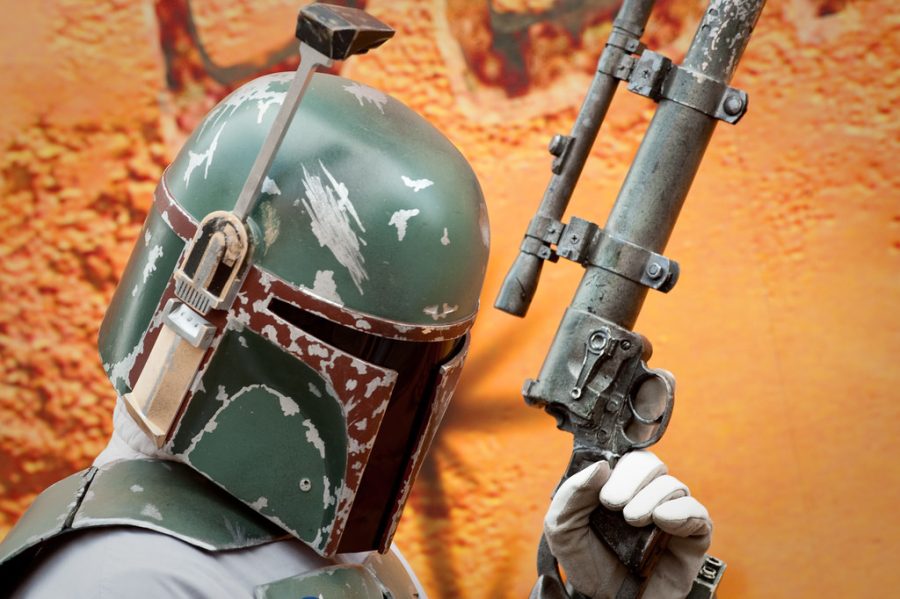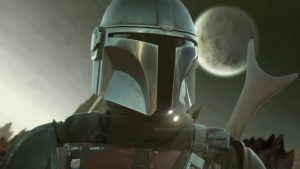‘The Book of Boba Fett’ Is a Tale of Redemption
Star Wars tackles themes of identity and renewal in the new Disney+ show ‘The Book of Boba Fett’
JOSH_HALLETT VIA FLICKR
What “The Book of Boba Fett” lacked in tone, it made up for with an entertaining story and an engaged fandom.
February 20, 2022
This review contains spoilers for “The Book of Boba Fett.”
When “The Book of Boba Fett” was originally announced in a post-credits scene after “The Mandalorian” season two finale, I was ecstatic for all of the possible directions in which this show could go.
The show was pitched to Disney investors as a halfway point between the second and third season of “The Mandalorian,” but as trailers and other promotions for the show were released, the story began to revolve more around Boba Fett. I recognize Disney’s attempts to reveal as little as possible in trailers so that audiences can be surprised, but the trailers and pacing of the show left me often confused as a viewer about the direction of the story.
The show begins with Boba escaping from the Sarlacc pit and joining the Tuskens in the year 5 A.B.Y. (after the Battle of Yavin). The Tuskens are killed, and Boba rescues Fennec Shand in 9 A.B.Y. After a series of flashbacks, the story continues where the post-credits scene left off. We see Boba attempting to reinvent himself as he unravels a growing threat against him by a rival crime syndicate led by the Pykes.
I enjoyed every episode, but it took me until the end of “Chapter 4” to feel that the story was progressing. The fifth and sixth episodes only included one scene with Boba, and there was no dialogue from him.
I absolutely loved the stories about Grogu, Din Djarin, Luke Skywalker and Ahsoka Tano. While their appearances may have served as an explanation for Grogu and Din’s appearance in the finale, these episodes were a disservice to Boba’s story.
The show succeeded in continuing Boba’s story from “Return of the Jedi” (1983) and connecting it to his other appearances in “Attack of the Clones” (2002) and “The Clone Wars” series. It focused on themes of trauma and the renewal of one’s identity.
This was not my favorite piece of Star Wars media, but I still enjoyed Boba’s tale and how it supplemented the story in “The Mandalorian.”
It felt relieving to finally see Boba’s story being told. His traumatic past was not dismissed, and it served as a motivator to improve himself. However, there was no motivation for me as a viewer to want Boba to defeat the Pykes.
As a knowledgeable fan, I am aware of the Pykes and their role in dealing spice from Kessel, but I never felt that there was much suspense between the two sides. I was excited to watch a new episode every Wednesday, but the lack of stakes between Pykes and Boba left me confused as a viewer as to where the story was going.
This was not my favorite piece of Star Wars media, but I still enjoyed Boba’s tale and how it supplemented the story in “The Mandalorian.”
My main issue with the show was the lack of character development for Fennec Shand. Though cast as a secondary main character, Fennec’s dialogue solely pushed the plot forward. Her character was never explored despite her years of experience as an assassin. Fennec was written as a stoic femme fatale stereotype, similar to other female characters Jon Favreau, showrunner for “The Book of Boba Fett,” has written, such as Black Widow and Cara Dune.
The writing for “The Book of Boba Fett” is credited mainly to Favreau, who wrote all seven episodes and co-wrote the sixth. While he is capable of amazing storytelling, I felt that this show needed a writer’s room. “Star Wars: The High Republic” series is proof that a diversified group of writers leads to diversified and entertaining storytelling.
I thoroughly enjoyed the various connections to other pieces of Star Wars media in each episode. The episodes can be enjoyed at surface level, but fans are always welcome to look deeper to make the story more satisfying. My favorite callbacks to other Star Wars media were in Chapters 5, 6 and 7.
“Chapter 5: Return of the Mandalorian,” directed by Bryce Dallas Howard, made callbacks to “The Phantom Menace” (1999), showing the audience that Din speeding through Tatooine would serve as a precursor to his sudden new way of life as it did for Anakin Skywalker.
While this may be my least favorite Star Wars Disney+ show, I still enjoyed getting more Star Wars content every Wednesday.
In “Chapter 6: From the Desert Comes a Stranger,” the bombing of the Sanctuary faded into a shot of the newly built structure. Although this is extremely subtle, I felt that this was an intentional decision made by director Dave Filoni since he shadowed director Rian Johnson on the set of “The Last Jedi” (2017). We see this same structure burnt down by Kylo Ren in that film. Filoni shows the beginning of Luke’s academy and the looming threat of its downfall that led to the rise of Kylo Ren and Luke’s isolation from the Jedi order.
What “The Book of Boba Fett” lacked in tone, it made up for with an entertaining story and an engaged fandom. The weekly releases allow for interesting discourse among passionate fans. However, not every viewer is going to be included in this discourse. I would not recommend “The Book of Boba Fett” as an entry point to the Star Wars universe, but I think with enough understanding of “The Mandalorian” and who Boba Fett is, you can enjoy the show.
While this may be my least favorite Star Wars Disney+ show, I still enjoyed getting more Star Wars content every Wednesday. I hope to see more of Boba Fett and Fennec Shand when the third season of “The Mandalorian” airs later this year, and I hope for acknowledgments to the “War of the Bounty Hunters” and “Crimson Reign” comics that align with the crime syndicate themes of this show.















